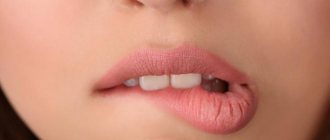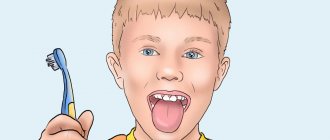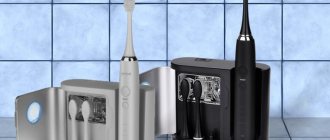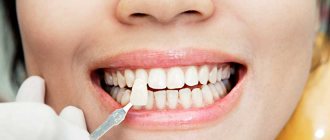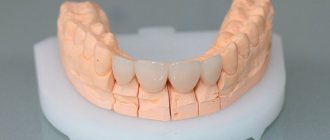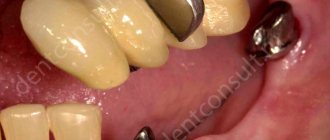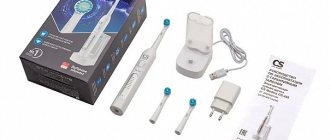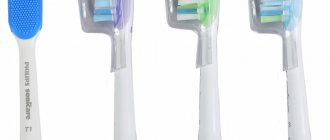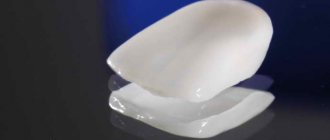Description and varieties
To understand which toothbrush is best, you should carefully examine the condition of your oral cavity. The first models appeared quite a long time ago. In ancient times, people took plant twigs, divided them into fibers and used them to brush their teeth. Dental hygiene devices have undergone significant modifications since then.
Which toothbrush is the best? It is impossible to give an exact answer to this question, since all people are different, and accordingly, we have to deal with various pathological conditions of the oral cavity. But, based on the key principles that the model must comply with, you can choose the right option. The classification combines types of toothbrushes:
- standard;
- electrical;
- ionic;
- ultrasonic.
Sometimes dentists recommend hard toothbrushes for people whose gums bleed. After such intensive treatment, the tissues are strengthened and the problem is solved. Experts warn that such a product may cause slight discomfort in the first days, which is fully justified in the future.
Which one to choose - an electric toothbrush or a regular one that works without batteries - is best decided after a detailed consultation with your doctor.
The standard model is a traditional device for maintaining oral hygiene. It contains a handle and a head on which the bristles are attached. There are different sizes of products intended for children and adults.
The decisive parameter when purchasing is the hardness of the pile. People who do not experience problems with the functional condition of their teeth and gums can get by with products of medium hardness. The brush does an excellent job of cleaning teeth, does not cause injury and does not leave marks.
The electric modification is suitable for those who love high-quality teeth cleaning combined with comfort. The device operates on batteries. The reduced size of the work area is a key difference. It usually has a round shape. The head is capable of producing circular and reciprocating movements. It vibrates, removing food particles and plaque without any problems.
Electrical
Progress does not stand still, and this also applies to tools for dental hygiene. There are various models and devices that make the cleaning process easier. However, due to the mass of features, they are not suitable for everyone.
The most common are electric. They have earned their popularity due to their attractive design and versatility. It has been proven that such a toothbrush removes plaque better than a regular mechanical one.
In the video, the author examines various types of electric assistants for brushing teeth:
Anna Losyakova
Dentist-orthodontist
Manufacturers offer customers various functions and capabilities. For example, you can adjust the speed of the head movement or view the battery charge level. Since electric toothbrushes themselves are expensive, models with replaceable heads have been developed that significantly reduce the cost of using them.
However, the use of such devices has severe limitations. They should not be used by those who suffer from periodontal disease or have recently undergone cancer surgery in the oral cavity. Contraindications also apply to those people who suffer from gingivitis and stomatitis. Healthy people are not recommended to use an electric brush more than 2 times a week, as it quickly wears away the enamel.
Types of working heads of electric brushes from a popular manufacturer
Recommendations for selection
There is a whole set of nuances that are important when choosing . These include:
- bristle material;
- head size;
- handle;
- inscriptions on the packaging;
- features of the end part.
As for the material from which the bristles are made, it can be natural or synthetic. Dentists are of the opinion that natural brushes are more prone to the accumulation of germs. This is why artificial pile is preferable. Adults should choose products with a head size of 25 to 30 mm.
A small working part is suitable for good cleaning. If she is too small, she will not be able to do her job. Bulky dimensions are also not good, since they do not provide the opportunity to treat chewing teeth and lateral areas.
The comfort of the handle is also of enormous importance. The handle should not be flexible or excessively thin. Because of this, the arm muscles will quickly get tired when cleaning. As for the inscription on the packaging, the degree of rigidity is important here. Experts recommend selecting this parameter individually. People who do not have any dental problems should have a brush with medium-hard bristles. It is important that the final area is rounded. This will protect the tooth enamel and avoid injury to soft tissues.
How to choose a toothbrush
When choosing, you should be guided by the following principles:
- First you need to decide on how to operate the brush. Manual models are driven by hand. In electric models, the head begins to move after the motor starts.
- The degree of rigidity is a parameter that must be taken into account. There are products with soft, hard or medium hardness. Hard models provide high-quality gum massage. If your gums are bleeding, it is recommended to buy soft or ultra-soft products, then the risk of injury to the oral cavity will be minimal. The standard is a brush of medium hardness.
- Depending on how the bristles are arranged, products can be single-level, two-level or three-level. Multi-level brushes provide for an arrangement of bristle tufts in which they are placed at a certain angle, forming a certain pattern on the surface.
- Bristles are very important for proper brushing of teeth. It should be neatly trimmed and located close to the plastic head. A two-level haircut allows you to quickly clean the interdental spaces. As a rule, caries occurs in such areas.
- The price of toothbrushes with V-shaped bristles ranges from 50 to 1000 rubles. Ionic models cost approximately from 100 to 1000 rubles. Ultrasonic products are the most expensive, their price ranges from 2,500 to 6,000 thousand rubles. Electrical devices cost from 1000 to 5000 rubles.
Important parameters
- Pay attention to the length of the cleaning head, it should be at least 25-30 mm.
- It is advisable to buy a cleaning head that has smoothly rounded transitions.
- Buy multi-beam models, they provide high-quality cleansing of the oral cavity.
- The appropriate degree of hardness is considered medium.
- The bristles must be made of high quality fibers; as a rule, artificial fibers are used in production, but natural fibers can also be used.
- The connection between the head and handle of the toothbrush must be movable. It is important that the pressure on the area of hard and soft tissues of the oral cavity is adjusted; without this, it will be difficult to control cleaning.
- When choosing electrical devices, pay attention to whether they are equipped with a pressure sensor. It is necessary to protect teeth and gums from microtraumas. A timer that signals the end of brushing the tooth surface won’t hurt either. As a rule, 2 cleaning modes are used.
Minor parameters
- The quality of teeth cleaning is affected not only by the quality of the brush itself, but also by the toothpaste.
- Buy brushes with rounded shapes, while the risk of damage to the oral cavity is minimized. The size of the product must correspond to the volume of the oral cavity. If you notice that brushing your teeth is not very convenient because there is little space left in your mouth and the brush cannot penetrate hard-to-reach places, then you should buy a smaller one.
- It is not recommended to buy models with a large head, as the effectiveness of teeth cleaning will be much lower.
Product care
The basics for proper use are the following:
- You should consider a toothbrush as an individual hygiene product. This means that only one person can use the product, otherwise it will simply turn into a source of infection.
- Storage rules must be followed. As soon as the product is used, you need to wash it thoroughly and place it vertically in a container with the top up. The microflora of family members should not overlap, and therefore each member should have their own products.
- The brush cannot be stored in a closed case, as it must be dry. A humid environment promotes the rapid spread of bacteria. The cover does not allow the brush to dry thoroughly.
- It needs to be changed every three months, or even more often. The hygiene product should not be worn out. This rule also applies to removable attachments for electric brushes. If the villi are deformed, you cannot continue to use the product. For this reason, mucous membranes and enamel may be damaged.
- The brush should always be washed with soap to remove any remaining plaque and toothpaste.
When choosing individual care products, it is better to seek advice from a specialist. Based on the individual characteristics of the body, the dentist will recommend certain models.
Rules of care
Just like any personal hygiene product, a toothbrush has special storage rules:
- Each family member should have a separate cup for storing brushes so that the working heads do not come into contact with each other and germs are not transferred from one hygiene product to another.
- You should not store them together with razors and other personal instruments, as this increases the possibility of contracting various diseases of the mucous membrane.
- You should not use a toothbrush for more than 3 months. After the expiration date, it must be replaced. In addition, it is necessary to buy a new one after suffering from infectious diseases, since the bacilli remain on personal hygiene items for a long time.
- Each time after brushing your teeth, the bristles must be treated with soap, preferably laundry soap, and left in it until the next brushing.
Following simple storage rules and a responsible attitude towards choosing a toothbrush will help ensure the health of your teeth.
LiveInternetLiveInternet
Archaeologists have proven that Neanderthals took care of their teeth. After examining the remains of teeth, which are more than 1.8 million years old, archaeologists have established that the small curved dimples on them are nothing more than the result of the influence of a primitive brush. True, she imagined just a bunch of grass with which ancient people rubbed their teeth. Also used for oral hygiene were ash, powdered stones, crushed glass, wool soaked in honey, charcoal, gypsum, plant roots, resin, cocoa grains, salt and many natural ingredients. In the written sources of Ancient Egypt there was mention of dental care and related products. According to the testimony of ancient chroniclers, about five thousand years ago, the Egyptians achieved pearly white teeth using powder from dry incense, myrrh, kau, branches of the mastic tree, ram's horn and raisins. The first prototype of a toothbrush appeared in Egypt; the toothbrush was a stick with a chewed “broom” at one end and a pointed tip at the other. The sharp end was used to remove food fibers, the other was chewed with teeth and used to remove plaque from teeth. These “brushes” were made from special types of wood containing essential oils and known for their disinfecting properties. Such “dental sticks”, about five thousand years old, are found in Egyptian tombs. In some corners of the Earth, such “primitive brushes” are still used - for example, in Africa they are made from twigs of trees of the El Salvador genus, and in some American states the indigenous population uses twigs of white elm. The first purpose-made gold toothpick was discovered in Sumer and dated to 3000 BC. e. An ancient Assyrian medical text described the procedure of cleaning teeth with the index finger wrapped in a cloth. Already in the second millennium BC. e. Tooth powder was used, made from pumice with the addition of natural acids - wine vinegar or tartaric acid. The credit for further improvement of toothpaste itself belongs to two great civilizations in human history - the ancient Greeks and Romans, because it was the Mediterranean states that became the cradle of medicine. Over time, toothpicks became not just a hygiene item, but also an indicator of the status of their owner - in Ancient India, China, and Japan they were made of gold and bronze. Relatively regular oral hygiene practices have been known since ancient Greece. Aristotle's student Theophrastus (died 287 BC) testified that the Greeks considered it a virtue to have white teeth and to brush them frequently. In the letters of the Greek philosopher Alciphron, who lived in the 2nd century BC. e., there is a mention of a hygiene product common at that time - a toothpick. The first toothpaste recipes date back to 1500 BC. The famous healer Hippocrates (460-377 BC) made the first description of dental diseases and recommended the use of toothpastes. In the second millennium BC. e. already used tooth powder made from pumice with the addition of natural acids - wine vinegar or tartaric acid. However, regular oral care did not become widespread until Greece became a province of Rome. Under Roman influence, the Greeks learned to use materials such as talc, pumice, gypsum, coral and corundum powder, and iron rust to clean teeth. Diocles of Karysto, an Athenian physician and contemporary of Aristotle, warned: “Every morning you should wipe your gums and teeth with your bare fingers, then rub mint inside and outside your teeth to remove any remaining pieces of food.” Body hygiene and oral hygiene in particular occupied a significant place in the life of the Romans. Its necessity was defended by the Roman physician Celsius. A recipe has been preserved for removing and preventing the formation of “black spots on teeth”: brush your teeth with a mixture of crushed rose petals, tannins and myrrh, and then rinse your mouth with young wine. Teeth cleaning powders with a large number of components were widely used. The bones, eggshells, and oyster shells that were included in their composition were burned, thoroughly crushed, and sometimes mixed with honey. The astringent components were myrrh and saltpeter, which simultaneously had a strengthening effect on the gums and teeth. The substance "nitrum" was mentioned - probably sodium or potassium carbonate. Guests invited to dinner were given not only spoons and knives, but also ornate metal toothpicks, often made of gold, which guests could even take home with them. A toothpick was to be used at every change of dishes. The ancient Greeks and Romans made toothpicks from wood, bronze, silver, gold, ivory and goose feathers in the form of thin sticks. The early Middle Ages brought the first evidence of professional cleaning of the oral cavity: the Greek Paul of Aegina (605-690) proposed removing tartar using a chisel or other tools. He also wrote about the need to maintain oral hygiene, in particular brushing teeth, after eating, emphasizing that various foods stick to the teeth and leave plaque. The concept of oral hygiene was introduced into the Arab world by the Prophet Mohammed (born in Mecca in 570 BC), introducing it into the Muslim religion. Among other requirements, the Koran requires rinsing the mouth three times before prayer (that is, 15 times a day). The Arabs cleaned their teeth according to the established ritual with the help of miswak - a stick made of fragrant wood with a split end like a brush and a chital toothpick - from the stem of an umbrella plant, and also from time to time they rubbed their teeth and gums with rose oil, myrrh, alum, and honey. The twig was soaked in clean water for about 24 hours until the fibers began to separate. The bark was removed, revealing a hard fiber that was quite flexible and easily split. The history of the development of oral care products after the fall of the Roman Empire is almost unknown until 1000 AD, which is when oral care instructions found during excavations in Persia date back. These guidelines warned against the use of too harsh tooth powders and recommended the use of antler powder, crushed snail and clam shells, and calcined plaster. Other Persian recipes included compositions from various dried animal parts, herbs, honey, minerals, aromatic oils, etc. In the Middle Ages, dental elixirs became fashionable in Europe, which were prepared by doctors and monks, and the recipe was kept secret. In 1363, the work of Guy de Chauliac (1300-1368) “The Beginnings of the Art of Surgical Medicine” appeared, which in 1592 was translated into French and was widely used by practicing doctors, becoming the main work on surgery of that time. The author divided dental treatment into two types: universal and individual. The biggest success was the tooth elixir. It was invented in 1373, but at the beginning of the twentieth century it was still sold in pharmacies. Chauliac's successor Giovanni do Vigo (1460-1525), author of the treatise “Complete Practice in the Art of Surgery,” recognized that healthy teeth have a beneficial effect on a person’s mental and physical health. To prevent tooth decay, he prescribed mixtures of pomegranate, wild olive and other plants for rinsing, and recommended regular removal of tartar. The Italian doctor Chigovani Arcoli (d. 1484) widely promoted the 10 rules he described for dental care, including after meals. In the 15th century in England, barbers who also practiced surgery used various metal instruments and solutions based on nitric acid to remove tartar (it is worth noting that the use of nitric acid for these purposes was stopped only in the 18th century). The first toothbrush like modern ones, made from pig bristles, appeared in China on June 28, 1497. What exactly did the Chinese invent? A compound brush with pig bristles attached to a bamboo stick. At times, however, other materials came into fashion, for example, badger hair. Gradually, the Asian “new product” began to be “exported” to other countries of the world, and the fashion for brushing teeth reached Russia. In Russia in the 16th century, similar “tooth brooms” were known, consisting of a wooden stick and a broom made of pork bristles - already under Ivan the Terrible, the boyars took out a “tooth broom” - a wooden stick with a tuft of bristles - from the pocket of their caftan at the end of a stormy feast. These inventions were brought to Russia from Europe, where panicles made of horse hair, badger bristles, etc. were also used with pork whisks. Under Peter I, the royal decree ordered that the brush be replaced with a cloth and a pinch of crushed chalk. In the villages, teeth were still rubbed with birch charcoal, which perfectly whitened teeth. Residents of the Japanese islands were introduced to a toothbrush and a tongue-cleaning twig by Buddhist priests, whose religion requires cleaning their teeth and tongue every morning before prayer. The Japanese “Samurai Code” ordered all warriors to brush their teeth after eating with soaked twigs of bushes. During the Tokugawa (Edo) period (1603-1867), toothbrushes were made from willow twigs, separated into fine fibers and specially processed. The brushes were of a certain length and flat in shape, so that they could be used as a tongue scraper. Toothbrushes for women were smaller and softer to preserve the black color of their teeth (women painting their teeth black was an ancient tradition). A polishing paste made from a mixture of earth and salt, scented with musk, was applied to the tip of the twig moistened with water. Toothpicks, similar to modern ones, were made by hand in Japan and sold along with brushes and powders, which appeared on the market as early as 1634. Colorful display cases invited customers to special stores where all dental care items were sold. By the beginning of the 19th century, the number of such stores increased sharply. There were more than two hundred of them on the street leading to the main Edo temple alone.
In 1530, the first book entirely devoted to dentistry was published in Leipzig. It was written in German, not Latin, and was addressed to barbers and surgeons. The famous 16th century surgeon Ambroise Paré recommended careful oral hygiene: remove all food debris from the teeth immediately after eating; it is necessary to remove tartar, as it acts on teeth like rust on iron; After removing stones from the teeth, the mouth should be rinsed with alcohol or a weak solution of nitric acid. To whiten teeth, weak solutions of nitric acid were most often used. English sources of the 16th century describe various means for caring for the oral cavity; rubbing teeth with fingers and cloth and using toothpicks were widely recommended. Toothpicks were imported from France, Spain, Portugal, were considered very fashionable and were included in the list of items required for the queen. The respect for these hygiene items is evidenced by the reverent report that in 1570, Queen Elizabeth of England received six gold toothpicks as a gift. Professional removal of dental plaque remained the job of barbers. Cintio d'Amato, in his book “New and Useful Methods for All Diligent Barbers,” published in 1632, Fr. In the 17th century, Europeans enthusiastically brushed their teeth with salt, which was later replaced by chalk. The indescribable surprise of the Dutchman A. Leeuwenhoek (1632-1723), who designed the microscope, is known to have discovered microorganisms in the plaque on his own teeth, “despite the fact that they were regularly cleaned with salt.” The first scientifically based presentation of material on oral hygiene belongs to Pierre Fauchard, who criticized the then prevailing opinion that the cause of dental diseases were some mysterious “tooth worms.” He identified 102 types of dental diseases. Fauchard argued that teeth must be brushed every day. The first mention of toothbrushes in European literature dates back to 1675. It is believed that the first manufacturer of toothbrushes was the Addis company (1780) in London. She used natural bristles for these purposes. In 1840, brushes began to be manufactured in France and Germany. Tooth powder, and then toothpaste, which are closest to modern ones, first appeared at the end of the 18th century in Great Britain. In the 19th century, most dentifrices remained in powder form, sold in special small paper bags. Now its goal was not only to remove plaque, but also to at the same time give freshness to the breath, for which various natural additives were mainly used, such as strawberry extract. To make these products more palatable, glycerin was added to tooth powders. In Western Europe and Russia, chalk-based tooth powders were widely used. The first tooth powders were made in pharmacies according to special recipes, then their industrial production was established. The basis of these powders was chalk and magnesium carbonate. Finely ground leaves or fruits of medicinal plants (cinnamon, sage, violet, etc.) were added to the powders. Later, these additives were replaced by various essential oils. In the second half of the 19th century, work began on the creation of toothpastes. The finest chalk powder was evenly distributed in the jelly-like mass. First, starch was used as a binder, from which a special paste was prepared in an aqueous solution of glycerin. Later, starch was replaced with a sodium salt of an organic acid, which stabilizes the chalk suspension. In 1873, Colgate introduced a flavored “liquefied” powder-paste in a glass jar to the American market, but consumers did not immediately accept the new product due to the inconvenience of packaging. At the end of the 19th century, it became clear that tooth bristles needed a revolutionary new material when the outstanding French microbiologist Louis Pasteur hypothesized that microbes and viruses were the cause of many dental diseases. And where is it most comfortable for them to reproduce, if not in the moist environment of the natural bristles of toothbrushes? As an option, dentists suggested boiling toothbrushes daily, thereby disinfecting them, but this procedure quickly wore out the bristles and made the brush unusable. In 1892, dentist Washington Sheffield invented the toothpaste tube. In 1894, a pump-fed tube was developed much like the ones we use today. In 1896, Mr. Colgate began producing toothpastes in tubes using his own technology, thanks to which both the tube and this paste received universal recognition in America and Europe. With the introduction of packaging in a tube, toothpaste has become a basic necessity for people. Since the end of the 19th century, the world began to switch to toothpastes in tubes. In most countries of the world, they came into use in the 30s of the 20th century and gradually began to replace tooth powders, since they had undeniable advantages - compactness, portability, plasticity, and better taste properties. In 1915, extracts from certain trees growing in Southeast Asia, such as eucalyptus, began to be introduced into the composition of the products. “Natural” toothpastes containing mint, strawberry and other plant extracts are also used. In 1937, specialists from the American chemical company Du Pont invented nylon, a synthetic material whose appearance marked the beginning of a new era in the development of toothbrushes. The advantages of nylon over bristles or horsehair are obvious: it is lightweight, quite durable, elastic, moisture-resistant, and highly resistant to many chemicals. Nylon bristles dried much faster, so bacteria did not multiply as quickly. True, nylon scratched gums and teeth quite a lot, but after some time Du Pont managed to fix this by synthesizing “soft” nylon, which dentists vied with each other to praise their patients. The end of the 30s of the 20th century was marked by another important event in the world of oral hygiene - the first electric toothbrush appeared. So, back at the end of the 19th century, a certain Dr. Scott (George A. Scott) invented an electric brush and even patented it in the American Patent Office. However, unlike modern devices, that brush “beat” a person with an electric current during use. According to the inventor, electricity could have a “beneficial” effect on dental health. A more humane toothbrush, powered by an electric network, was created in 1939 in Switzerland, but production and sales began only in 1960, when the American pharmaceutical company Bristol-Myers Squibb released a toothbrush called Broxodent. It was planned that it would be used by people who have problems with fine motor skills, or those whose teeth have non-removable structures (braces). In 1987, the antibacterial component triclosan began to be included in toothpastes. The USSR lingered in the era of tooth powder for almost three-quarters of a century; the first Soviet toothpaste in a tube was released only in 1950. Before this, pastes were sold in tin, and later in plastic jars. True, even in this package, toothpaste appeared on store shelves quite rarely; the undisputed leader in sales was tooth powder, which became so firmly established in the life of Soviet people that it penetrated into areas unusual for its intended purpose. In home economics books of the time, you will find tips on using tooth powder to clean windows, clean canvas shoes, or shine metal utensils. The powder went away following the fashion for canvas. Consumers enthusiastically accepted the new product - a foamy and fragrant toothpaste. In 1961, General Electrics introduced its version of the electric toothbrush, designed for use by all people without exception. Unlike older models, this safer toothbrush did not work from the mains, but was powered by a built-in battery. Over the next forty years, only the lazy did not try to experiment with a toothbrush. Experts say that between 1963 and 2000, more than 3,000 toothbrush models were patented. What they did with them: first the brush was equipped with a built-in timer, then it became possible to replace the cleaning heads, later they released electric rotating brushes, and then reciprocating rotating brushes. The bristles of the brushes began to be covered with a pigment that gradually wore off, which reminded the owner of the need to replace the brush. Then brushes with rounded ends of the bristles appeared, which were safer for teeth and gums. The development of electric toothbrushes continues actively today. Before we had time to learn how to use them properly (these devices appeared in Russia 15 years ago), an electric toothbrush was invented, and a little later an ultrasonic brush appeared. Recently, a brush was introduced in Japan that connects to a computer via a USB port. Time will tell where miracle technologies will take us tomorrow...
Source of information: www.istorya.ru/articles/zuby.php Healthy teeth are a beautiful smile, a beautiful smile is always a pleasant communication. A smile costs nothing, but is highly valued... D. Carnegie
